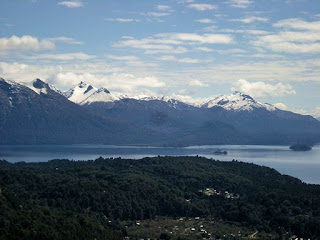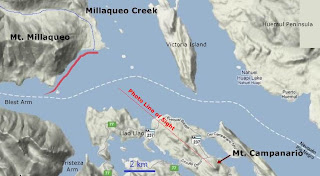Western Nahuel Huapi, Millaqueo Bay from Mount Campanario . Copyright © 2011 by Austin Whittall
This morning I was looking at the photographs taken during our recent trip to Bariloche, when we went up the chairlift to the summit of Mount Campanario, a solitary cone shaped mountain that lies on the southern shore of Lake Nahuel Huapi which is 1,030 m (3,377 ft.) high.
From the mountain top (which has a nice cozy restaurant where you can enjoy a hot chocolate laced with cognac!), the view is impressive. To the East, the city of Bariloche, 20 km away and beyond it, the Patagonian steppe and the eastern tip of Lake Nahuel Huapi.
To the North, the lake itself, majestic, with the forest covered hills that enclose it. Snow on the mountain tops as it is mid Spring. Far to the North, the peaks of the Andes that mark the border between Argentina and Chile. To the West, more mountains and a view of the Tristeza and Blest Arms of the lake. And, Behind us, to the South, Lake Moreno and the tall mountains (López, Capilla, Goye, Catedral -with its ski resort), and to the South East, the Otto and Ventana Mountains.
The forest, the deep blue lakes, the snow and clouds. A great scenery!
Anyway, one of the photos that we took, showed Millaqueo Bay. Behind it is Mount Millaqueo (1,800 m - 5,900 ft.) on the left, and Mount Vinagre (1,870 m - 6,131 ft.) and Colorado (1,900 m - 6,229 ft.) (center and right).
A large stream flows into the Bay's northern shore, Millaqueo Creek, this part of the bay is relatively flat and has a nice sandy beach. Its western shore is steep and forested.
Map of Millaqueo Bay. Based on Google EArth maps
The "big fish" incident
I was fishing here with my father in the early 1970s, I think it was 1975. We used to bring our boat all the way from Buenos Aires to fish for trout, trolling the lake if the weather allowed us to.
It was a 4.5 m (14.75 ft.) fiberglass speedboat equipped with a 90 HP Chrysler outboard motor. We used to troll for hours, leaving home early in the morning, at sunrise and getting back by midday.
On this particular day we decided to fish along the lake's western coast in the area by Millaqueo. We had equipped our lines (we used two canes, on on each side of the boat) with a flatfish lure. We added a small lead-sheet weight wrapped round the tip of the line to sink the lure even deeper (without the weight the lures sank to a depth of about 1 m - 3 ft., with the lures weighed down, they sank to about 3 m - 9 ft.).
With this method we had caught some big (5 kg - 11 lbs.) brown trout! Which we smoked and ate the following winter.
This morning, we began trolling at the mouth of the lake's Blest Arm, parallel to the coast, about 50 yards from it, going north. When we reached the mouth of Millaqueo Stream, I got a tug on my line. (the map shows our course, in red).
The usual sign of a bite was that the line began to run out from the spool. We had adjusted the fishing-reel's brake to allow the line to be drawn out if a fish took the lure. My Dad stopped the engine and I started to reel the line in. The brake was skidding even though the boat had stopped dead. This "fish" was pulling the line out faster than I could reel it in!
I tightened the brake a little (a delicate balance the tightness issue, I had lost some fish because the line cut due to an over-tight brake) to slow the "fish" down and kept on reeling in as fast as I could. But the line kept on running from the spool until it came to an end, tensed, became more and more taught, and cut!
We used a 0.4 mm mono-filament nylon line, which could withstand fish weighing up to 11 kg (24 lb.) so we were quite surprised at what had happened.
We had fished in the Patagonian lakes for many years, caught dozens of trout of all kinds and sizes (many were returned unharmed to the water). But not once did we lose a fish because it took the whole line and then cut it! We had big reels with over 150 m (491 ft.) of nylon line in them.
What bit my lure and drew all the line is a mystery. It must have been a very big fish. Which, by the way did not jump out of the water, not even once. Rainbow trout, once they bit the lure, jumped out of the water. But this trout stayed submerged.
We often wondered what "fish" it could have been. I don't know. It was not an underwater snag as the lake is deep there, and a rock or tree would not have taken the line from my reel.
Who knows! I only hope that it wasn't a Patagonian otter (huillín), though we never saw one of them in the lake.
2011 and the "big fish"
The reason I wrote about the big fish 36 years later, is because, if you take a good look at the photo above, in the central part of the image, close to the northwestern shore, by the mouth of Millaqueo Stream, you will see an odd thing on the lake's surface. Below is the zoomed image:
Detail showing "circular ripple" at Millaqueo Bay. Copyright © Austin Whittall 2011
The lake is perfectly calm except for this circular shaped ripple, which is quite big considering how far away it is from my observation point!.
Perhaps the "big fish" is still alive and kicking!
Patagonian Monsters - Cryptozoology, Myths & legends in Patagonia2011 International Year of Forests Copyright 2009-2011 by Austin Whittall ©




















In fishing, you have to think like the fish. You need to know all you can about the fish that you want to catch -- what kind of lure you should use, their behavior. About the fish that escaped, that must’ve been a really big fish, or a small shark.
ReplyDelete